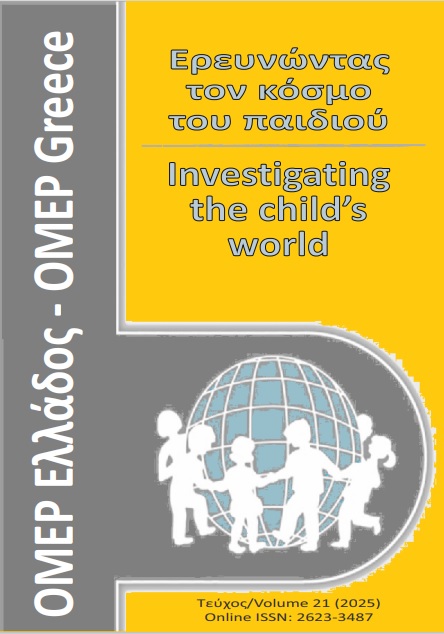Αξιολόγηση του δεσμού γονέα-παιδιού σε μαθητές με Νευροαναπτυξιακές Διαταραχές μέσω της προβολικής δοκιμασίας «φωλιά πουλιών»

Περίληψη
Ο συναισθηματικός δεσμός με το κύριο πρόσωπο φροντίδας αποτελεί έναν σημαντικό προβλεπτικό παράγοντα για τις σχέσεις που θα διαμορφώσει το παιδί κατά την πορεία της ανάπτυξής του. Παρότι ο ανασφαλής δεσμός έχει συσχετιστεί σε νευροβιολογικό επίπεδο με την απορρύθμιση του συναισθήματος και με τις νευροαναπτυξιακές διαταραχές, υπάρχουν λίγες διαθέσιμες εμπειρικές μελέτες σε παιδιά σχολικής ηλικίας. Μέσα από την παρούσα μελέτη επιχειρούμε να αξιολογήσουμε τον τύπο δεσμού που εμφανίζουν μαθητές ειδικού σχολείου που έχουν διαγνωστεί με νευροαναπτυξιακές διαταραχές. Ο δεσμός των παιδιών με τον γονέα αξιολογήθηκε μέσα από τη δοκιμασία «φωλιά πουλιών». Παράλληλα, διενεργήθηκαν συνεντεύξεις με τους γονείς από τον ψυχολόγο και την κοινωνική λειτουργό του σχολείου και στη συνέχεια οι ειδικοί διατύπωσαν τις εκτιμήσεις τους αναφορικά με τον τύπο δεσμού που εμφάνιζε ο κάθε μαθητής. Κατά την εφαρμογή της προβολικής δοκιμασίας ζητήθηκε από τον κάθε μαθητή να ζωγραφίσει μια φωλιά πουλιών και στη συνέχεια να αφηγηθεί μια ιστορία. Στη μελέτη συμμετείχαν 8 μαθητές (6 αγόρια, 2 κορίτσια, 9-12 ετών) με νευροαναπτυξιακές διαταραχές που είχαν κατακτήσει τον λόγο και φοιτούσαν σε ειδικό σχολείο. Έξι μαθητές εμφάνισαν ανασφαλή και δύο ασφαλή δεσμό. Αποτυπώθηκε συμφωνία μεταξύ του συστήματος βαθμολόγησης της προβολικής δοκιμασίας και της κλινικής εκτίμησης που προέκυψε από τις συνεντεύξεις με τους γονείς. Τα ευρήματα της παρούσας μελέτης παρέχουν κάποιες ενδείξεις ότι η προβολική δοκιμασία «φωλιά των πουλιών» μπορεί να λειτουργήσει ως ένα πολύτιμο εργαλείο ανίχνευσης ζητημάτων που σχετίζονται με τον δεσμό παιδιού-γονέα σε μαθητές που φοιτούν σε ειδικό σχολείο.
Λεπτομέρειες άρθρου
- Πώς να δημιουργήσετε Αναφορές
-
Τσουβέλας Γ., Δαργωνάκη Ε., & Παπουλίδη Α. (2025). Αξιολόγηση του δεσμού γονέα-παιδιού σε μαθητές με Νευροαναπτυξιακές Διαταραχές μέσω της προβολικής δοκιμασίας «φωλιά πουλιών». Ερευνώντας τον κόσμο του παιδιού, 21, 26–44. ανακτήθηκε από https://ejournals.epublishing.ekt.gr/index.php/omep/article/view/36540
- Τεύχος
- Τόμ. 21 (2025)
- Ενότητα
- Επιστημονική αρθρογραφία & εκπαιδευτικές δράσεις

Αυτή η εργασία είναι αδειοδοτημένη υπό το CC Αναφορά Δημιουργού – Μη Εμπορική Χρήση 4.0.
Οι Συγγραφείς που δημοσιεύουν εργασίες τους σε αυτό το περιοδικό συμφωνούν στους παρακάτω όρους:
Οι Συγγραφείς διατηρούν τα Πνευματικά Δικαιώματα και χορηγούν στο περιοδικό το δικαίωμα της πρώτης δημοσίευσης ενώ ταυτόχρονα τα πνευματικά δικαιώματα της εργασίας προστατεύονται σύμφωνα με την Creative Commons Attribution License που επιτρέπει σε τρίτους - αποδέκτες της άδειας να χρησιμοποιούν την εργασία όπως θέλουν με την προϋπόθεση της διατήρησης των διατυπώσεων που προβλέπονται στην άδεια σχετικά με την αναφορά στον αρχικό δημιουργό και την αρχική δημοσίευση σε αυτό το περιοδικό.
Οι Συγγραφείς μπορούν να συνάπτουν ξεχωριστές, και πρόσθετες συμβάσεις και συμφωνίες για την μη αποκλειστική διανομή της εργασίας όπως δημοσιεύτηκε στο περιοδικό αυτό (π.χ. κατάθεση σε ένα ακαδημαϊκό καταθετήριο ή δημοσίευση σε ένα βιβλίο), με την προϋπόθεση της αναγνώρισης και την αναφοράς της πρώτης δημοσίευσης σε αυτό το περιοδικό.
Το περιοδικό επιτρέπει και ενθαρρύνει τους Συγγραφείς να καταθέτουν τις εργασίες τους μέσω διαδικτύου (π.χ. σε ένα ακαδημαϊκό καταθετήριο ή στους προσωπικές τους ιστοσελίδες) πριν και μετά από τις διαδικασίες της δημοσίευσης, καθώς αυτό μπορεί να οδηγήσει σε παραγωγική ανταλλαγή ιδεών και σκέψεων καθώς επίσης και σε γρηγορότερη και μεγαλύτερη χρήση και ευρετηρίαση της δημοσιευμένης εργασίας (See The Effect of Open Access).


